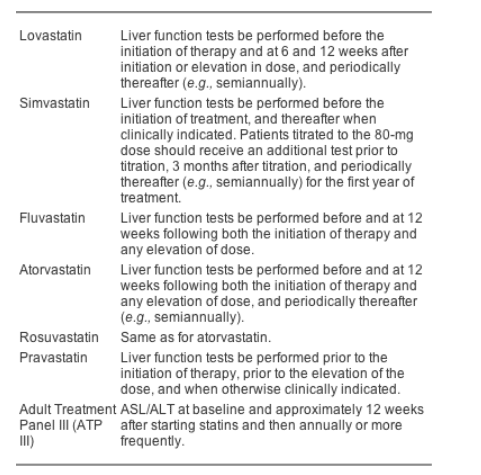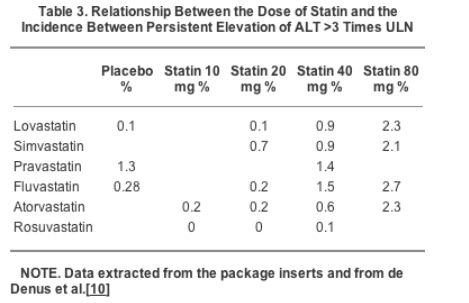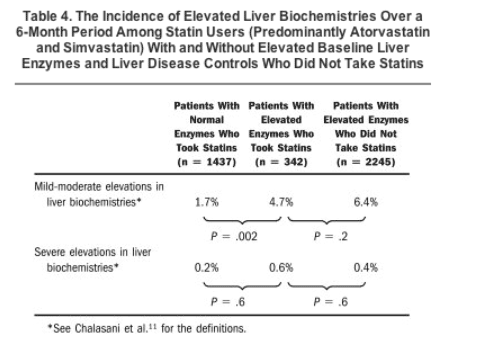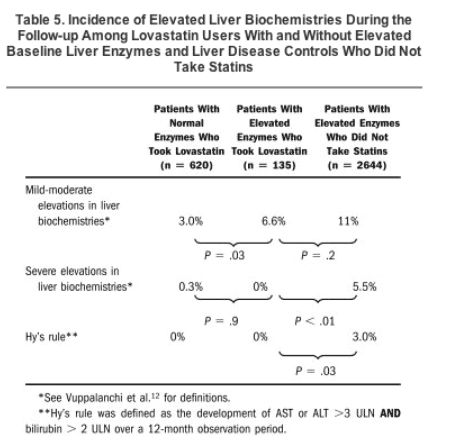| |
Statins and hepatotoxicity: Focus on patients with fatty liver
|
| |
| |
Carcinogenicity of statins also discussed below.
Hepatology
April 2005
Naga Chalasani *
Indiana University School of Medicine, Indianopolis, IN
Article Text
Statins are among the most widely prescribed medications in the western world.[1] Their benefit in the primary and secondary prevention of cardiovascular disease is unequivocal. The results from clinical trials have shown that statins decrease the mortality from coronary artery disease and decrease the incidence of myocardial infarction, revascularization procedures, stroke and peripheral vascular disease.[2] Currently, six statins are available for clinical use including lovastatin which is available in a generic form in the United States. These medications are widely prescribed and more than 10 million prescriptions were written in the United States in the year 2003 alone[3]. Numerous clinical trials and extensive clinical experience have established that currently available statins have an excellent safety profile. Although clinically significant liver injury is extremely rare from statins, asymptomatic elevations in liver enzymes are common in patients who are placed on statins. Because of this phenomenon and due to the information contained within the package inserts, potential hepatotoxicity from statins has become a source of concern for physicians who prescribe them. In clinical practice, gastroenterologists and hepatologists are often asked to see patients who developed liver enzyme elevations after prescribing statins and also about the safety of prescribing statins in hyperlipidemic individuals with asymptomatic liver enzyme elevations. This article discusses various aspects of statin hepatotoxicity including the safety of statins in patients with nonalcoholic fatty liver disease (NAFLD) and the merits of current product labeling (Table 2). The issue of using statins in patients with known or suspected fatty liver disease is particularly relevant as statins are now available without a prescription in some parts of the world (United Kingdom) and thus a large number of individuals with undiagnosed fatty liver disease may consume statins without their knowledge.
Table 2. Current Recommendations of Liver Test Monitoring by the Manufacturers and the Adult Treatment Panel III (ATP III) for Patients Receiving Statins
|
|
 |
| |
Statin Hepatotoxicity: Elevated Aminotransferases Versus Clinically Significant Liver Injury
Initial toxicology studies in animals suggested that statins may cause significant liver problems. Although the usual doses of lovastatin did not cause significant liver injury, when given in very high doses they caused hepatocellular necrosis in rabbits.[4] Similarly, high doses of simvastatin caused hepatocellular necrosis in guinea pigs.[5] The liver injury in these animals could be prevented or reversed with supplementing animals with mevalonate suggesting that depletion of mevalonate or its downstream metabolite might be responsible for liver injury.[4][5] However, it does not appear that statins cause hepatocellular necrosis in a predictable fashion in humans.
The most common clinical hepatic manifestation of statins is asymptomatic elevation in aminotransferases and this appears to be a class effect of statins.[2][6-8] The clinical trials that evaluated the efficacy of statins have arbitrarily but consistently used persistent and significant elevation in alanine aminotransferase levels (>3 times upper limit of normal [ULN] on two or more measurements) as a safety end point. The incidence of this abnormality with different statins is less than 3% and there is a minor dose-related increase in its incidence[2][7] (Table 3). Very rarely, after initiating statins, the liver enzymes can rise to significantly higher levels with no evidence of liver dysfunction. For example, in the prospective pravastatin pooling project (PPP project), 0.5% of the patients who received 40 mg of pravastatin had ALT greater than 5 times ULN and 0.2% had ALT greater than 9 times ULN.[9] In general, the incidence of liver enzyme elevations in the statin treated patients has not been consistently different than in the placebo-treated patients.[9][10] In a recent meta-analysis that consisted of 49,275 patients who participated in 13 large, placebo-controlled trials of statins, therapy with statins at low-to-moderate doses was not associated with a significant increase in liver enzyme elevations compared to placebo (OR 1.26, 95% CI 0.99-1.62).[10] This comparable incidence of liver enzyme elevation between statin and placebo-treated patients raises the possibility that hyperlipidemic patients may have spontaneous fluctuations in transaminases whether or not they receive statins.[9-12]
|
|
| |
 |
| |
In patients who exhibit elevated aminotransferases, the liver enzymes decrease upon stopping or reducing the dose.[6] However, the natural history of elevated aminotransferases if the statins are continued at the same doses is not well known. There is a suggestion that such patients may exhibit adaptation and their aminotransferases remain stable or trend downwards even when statins are continued.[6] Although several reports of significant liver injury associated with statins have appeared in the literature, it appears to be very rare.[8][13-16] Statins do not appear to have a signature pattern of clinically significant hepatotoxicity as all common patterns of liver injury (hepatocellular, cholestatic or mixed) have been reported with all available statins.[8][15] It recently has been reported that statins may induce or unmask autoimmune liver disease, although the mechanism by which they induce this phenomenon is unknown.[17-19] However, this phenomenon appears to be quite rare. Irreversible liver damage leading to death or liver transplantation appears to be extremely uncommon with statins, especially when one considers the magnitude of their use worldwide. Based on 232 cases of acute liver injury potentially associated with lovastatin reported to Merck's World-wide Adverse Event Database (WAES), it was estimated that risk of fulminant liver failure attributable to lovastatin was 2 in one million patients.[14][15] Of 51,741 patients who had liver transplantation performed in the United States between 1990 and 2002, there were three patients who had liver transplantation performed for acute liver failure presumably caused by statins.[20] Of these three patients, two had acute liver failure caused by cerivastatin, which is no longer available in the market, and one had liver failure apparently caused by simvastatin.[20]
There are no identified risk factors that increase the frequency of hepatotoxicity in patients who receive statins with the exception of higher (but clinically insignificant) likelihood of asymptomatic elevation in aminotransferases in those receiving higher doses of statins (Table 3).[4][8][15] There is no evidence to suggest that patients who receive higher doses of statins are more likely to develop clinically significant liver injury. For example, in the report by Perger and colleagues, fatal liver failure occurred in an elderly patient with 20 mg of atorvastatin.[16] Similarly, there exists no convincing relationship between older age, gender, underlying comorbidities (including liver disease) or type of statin and the risk of significant liver injury from statins.[8] While the risk of myopathy and rhabdomyolysis from statins is increased due to drug interactions with other lipid lowering agents (notably fibrates) or other medications, there is no evidence that such drug interactions play a role in the pathogenesis of rare cases of clinically significant liver injury caused by statins.[8][21][22]
The mechanism by which statins cause asymptomatic elevation in aminotransferases is unknown. It has been speculated that increased aminotransferases may actually represent a pharmacodynamic effect of lipid lowering, rather than a direct effect of the statins.[15] This explanation appears to be a plausible because asymptomatic elevation in aminotransferases occurs with all lipid-lowering agents including ezetimibine which has no effect on hepatic cholesterol synthesis or bile acid excretion.[4]. Idiosyncratic and immunoallergic mechanisms have been implicated in the pathogenesis of rare cases of clinically significant liver injury caused by statins.[6][13-16]
Statins in Patients With Nonalcoholic Fatty Liver Disease
The current labeling that statins should not be used in patients with active liver disease or unexplained persistent aminotransferase elevation is ambiguous as it does not define which patients should be considered to have active liver disease or unexplained persistent aminotransferase elevation.[4]. It is not clear from the package inserts[4] or from the ACC/AHA/NHLBI Clinical Advisory[2] whether statins should be used in hyperlipidemic patients with proven or suspected nonalcoholic fatty liver disease (NAFLD). Although there are no supporting direct data, due to their effects on hepatic cholesterol and apolipoprotein synthesis, Caldwell et al. raised the theoretical possibility of statins given for long term may worsen hepatic histology in patients with NAFLD.[23] This issue is important not only because NAFLD is common in patients with hyperlipidemia and type 2 diabetes (primary targets for long term statins)[24-27] but the presence of fatty liver disease may itself portray higher cardiovascular risk necessitating statin therapy.[28-30]
The studies examining the safety of statins in patients with NAFLD are limited, but the existing data provide some evidence that they can be used safely in patients with proven or suspected NAFLD who require statins for primary or secondary prevention of cardiovascular disease. We have recently shown that hyperlipidemic patients with elevated baseline liver enzymes are at not higher risk for hepatotoxicity (as defined biochemically) than hyperlipidemic patients with normal transaminases.[11] In this study, the incidence of statin hepatotoxicity over a 6-month period in 342 hyperlipidemic patients with elevated baseline enzymes (AST >40 IU/L or ALT >35 IU/L) who received statins was compared to 1437 hyperlipidemic patients with normal aminotransferases who received statins (statin controls) and 2245 patients with elevated liver enzymes who did not receive statins (liver disease controls).[11] Elevations in liver biochemistries during a 6-month follow-up were categorized into mild-moderate or severe based on predefined criteria.[11] Compared to statin controls, patients with elevated baseline liver enzymes had higher incidence of mild-moderate elevations (4.7% vs. 1.9%, P = .002) but not severe elevations (0.6% vs. 0.2%, P = .2) (Table 4). However, patients with elevated baseline liver enzymes who received statins did not have higher incidence of mild-moderate elevations (4.7% vs. 6.4%, P = .2) or severe elevations (0.6% vs. 0.4%, P = .6) than the liver disease controls who did not receive statins (Table 4).[11] These data showed that some individuals with elevated baseline liver enzymes have increases in their liver biochemistries, whether or not they receive statins.[11]
|
|
| |
 |
| |
As 97% of patients in the aforementioned study received either atorvastatin or simvastatin, in a subsequent study of similar design, we examined if patients with elevated liver enzymes were more likely to have hepatotoxicity from lovastatin (first generation statin) than those with normal liver enzymes[12] (Table 5). This study also showed that hyperlipidemic individuals with elevated baseline liver enzymes did not have higher frequency of lovastatin hepatotoxicity than those with normal liver enzymes, as defined biochemically.[12] One may suggest that hyperlipidemic patients with elevated baseline liver enzymes in these two studies predominantly had NAFLD, as they had no evidence of other common etiologies (e.g., HBV or HCV or alcohol abuse).
|
|
| |
 |
| |
These results are consistent with the findings of the PPP project which provided quantitative data on the safety and tolerability of pravastatin administered over a median duration of 5 years.[9] Of the 19,592 patients evaluated in this project, 319 pravastatin treated patients and 262 placebo-treated patients had elevated baseline ALT (between 1 and 3 times ULN).[9] The incidence of significantly elevated ALT at any time during the postrandomization was 5% in the pravastatin group and was not different from the placebo-treated patients (7.3%).[9]
The effect of statins on hepatic histology in patients with biopsy-proven NASH was examined in two small open-label studies.[31][32] In one study, 20 mg pravastatin was administered to five patients with NASH for 6 months and the hepatic histology was reexamined in four patients.[31] Liver enzymes were normalized in all five patients and there was some improvement in hepatic inflammation and steatosis.[31] In another study, atorvastatin was explored as treatment for NASH in seven patients and liver histology was reexamined after receiving atorvastatin for a mean duration of 21 ± 2 months.[32] The authors reported that atorvastatin was well tolerated with no significant increases in liver chemistries and some patients exhibited significant improvement in hepatic histology.[32]
Are Statins Carcinogenic in Humans?
As statins have been shown to cause various tumors including hepatic adenomas and carcinomas in rodents,[4][33] concerns about the potential carcinogenicity of long-term use of statins have been raised.[3][34] Although this is a very important question, data are sparse and studies to address this question are difficult to design and conduct.[35] A meta-analysis of five large clinical trials consisting of 30,817 patients (15,420 receiving statins) demonstrated no association between statin use over a 5-year period and the risk of fatal and nonfatal cancers.[36] Due to its short follow-up, this study was unable to estimate the cancer risk resulting from longer exposure to statins.[36] More recently, the Scandinavian Simvastatin Survival Study (4S) reported that there was no difference in the cancer incidence or mortality between the original simvastatin and placebo groups over a 10-year follow-up.[37] However, as majority of placebo-treated patients were switched to simvastatin after 5 years, the interpretation of these long-term results is complicated.[37] As long-term, placebo-controlled studies may not be feasible due to ethical issues, pharmacoepidemiological studies should be pursued to address the association between statin use and cancer risk.[35] This area of research is especially important because of animal studies and some small human studies suggest that statins may potentially have antitumor effects.[38-40]
Are Patients With Liver Disease at Higher Risk for Rhabdomyolysis From Statins?
Rhabdomyolysis (is the most important complication of statin therapy.[41] Although there is not a linear relationship, it is generally believed that the risk of rhabdomyolysis increases with increasing serum concentrations of statins.[41-43] Patients with decompensated cirrhosis are likely to have higher serum concentrations of statins due to their reduced hepatic activity of CYP3A and other drug metabolizing enzymes[44][45] but human studies evaluating the pharmacokinetics of statins in patients with cirrhosis are limited. The plasma concentration of rosuvastatin (a potent statin that is not extensively metabolized) is increased in patients with chronic alcoholic liver disease and in patients with Child-Turcotte-Pugh A and B cirrhosis compared to volunteers with normal liver function.[4] These data lead to the speculation that patients with cirrhosis may have higher risk of myopathy from statins, but there are no reports of such association, possibly because statins have not been used extensively in such patient population. Data suggest that patients with steatosis and NASH have decreased hepatic CYP3A expression and activity[46] and one may also speculate that they carry higher risk of myopathy from statins that are metabolized predominantly by CYP3A (e.g., atorvastatin, simvastatin), especially when used at higher doses. In a study by Weltman and colleagues, hepatic tissue from patients with NASH had decreased CYP3A expression by immunostaining compared to normal liver tissue.[46] A recent study presented by our group at the 2003 ISSX (International Society for the Study of Xenobiotics) meeting also showed that hepatic steatosis is associated with significantly lower hepatic CYP3A activity (Prof. Stephen Hall, Indiana University, personal communication, 2005). More research is needed to investigate if patients with NAFLD and NASH exhibit any clinically relevant alterations in the pharmacokinetics of different statins at various doses.
Is the Current Labeling Clinically Relevant?
The current recommendation that liver biochemistries be checked before and periodically after starting statin therapy is not evidence-based and is controversial[4] (Table 2). The presumed purpose of this recommendation is to identify patients with liver disease so that statins can be avoided in them, and to monitor for statin hepatotoxicity. However, this recommendation is fraught with problems and requires further review. It is now evident that elevated aminotransferases are insensitive to detect underlying hepatic steatosis and patients with advanced fibrosis and cirrhosis may have entirely normal aminotransferases.[27][47] For example, 79% of adults with documented hepatic steatosis in the Dallas Heart Study had normal aminotransferases,[27] and in the study by Mofrad and colleagues, 36% of NAFLD patients with normal ALT had bridging fibrosis or cirrhosis.[47] Thus, measuring aminotransferases at baseline cannot adequately identify those who have underlying liver disease, and importantly, there is no sound rationale why statins should not be used in patients with chronic liver disease who otherwise need statin therapy. While routine monitoring of liver biochemistries will identify patients who develop elevated aminotransferases, physicians are neither compliant with this recommendation[11][48][49] nor there is any evidence that it is cost-effective in identifying the rare cases of clinically significant liver injury from statins.[14] Therefore, this recommendation needs to be reexamined by the manufacturers, regulatory agency and researchers in the field.
Conclusion
Unquestionably, statins are extremely valuable for treating human disease and they are here to stay. The available data indicate that statins are remarkably safe from a hepatic standpoint, but there are several issues related to their usage in humans that require further research and scrutiny. First, the long-term effects of statins on hepatic histology should be carefully studied in patients with fatty liver and NASH. Although two small studies have shown that statins may possibly improve hepatic histology in patients with underlying NAFLD, more studies should be conducted to evaluate the long-term effects of statins on hepatic histology. Second, as preliminary studies suggest that hepatic steatosis may modulate the activity of important cytochrome P450 enzymes, more research should be conducted to confirm these findings and also to investigate if patients with NAFLD and NASH exhibit any clinically relevant alterations in the pharmacokinetics of different statins at various doses. Third, more epidemiological studies should be conducted to monitor for any signals of carcinogenicity from prolonged use of statins. All these issues are important because more people are taking statins at a young age for primary prophylaxis and because higher-dose or higher-potency statins are taken to reach the newer target serum LDL levels (70 mg/dL). Finally, the current recommendations regarding liver biochemistry monitoring before and during statin therapy are not necessarily clinically meaningful and they need to be reexamined by the manufacturers, regulatory agency and researchers in the field.
|
|
| |
| |
|
|
|